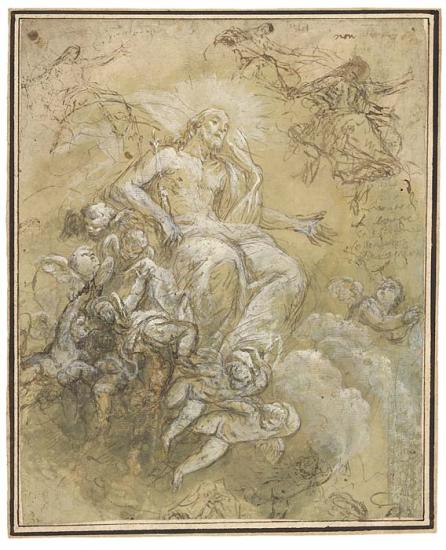
Studies of Christ in Glory
Purchased on the Seligman Charitable Trust Fund, 2013
A NEWLY DISCOVERED DESIGN FOR AN ALTARPIECE
This recently discovered sheet has been attributed to Carreño de Miranda, an artist who succeeded Velázquez as the most talented portrait painter in Madrid. The energetically described Christ borne aloft by putti recalls the composition of Carreño's altarpiece depicting the Mass of St. John of Matha, commissioned by the Trinitarian order for their new monastic church in Pamplona. Since Carreño is less known as a draftsman and few examples of his work in ink and wash survive for comparison, it leaves open the possibility that this study was executed by another Spanish, or even Italian, artist.
From the sixteenth to nineteenth centuries, Spain witnessed the rise of the Catholic Church along with the flourishing of court artists who explored deeply spiritual visions. Concurrently, the nightmare of the Inquisition drove artists to probe the darker side of human nature through scenes of martyrdom and torture. Drawing played a central role in their conception of these diverse subjects—from Murillo's preparatory studies for painting commissions to Goya's private albums satirizing contemporary society. In addition to this rich tradition in Spain, Spanish artists also worked abroad, notably in Naples, which was a Spanish territory.
Visions and Nightmares marks the first exhibition of Spanish drawings at the Morgan, whose holdings in this area are small but significant. Showcasing over twenty sheets by Spanish artists spanning four centuries, this selection traces the shifting roles and attitudes toward the art of drawing in Spain.
This online exhibition was created in conjunction with the exhibition Visions and Nightmares: Four Centuries of Spanish Drawings, on view January 17 through May 11, 2014 and organized by Edward Payne, Moore Curatorial Fellow.
This exhibition is made possible by the A. Woodner Fund.
